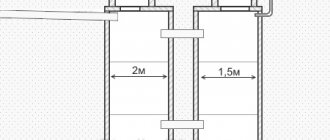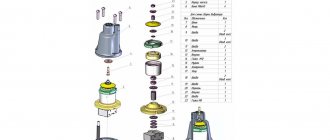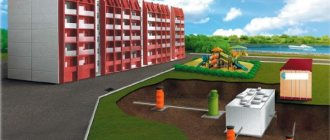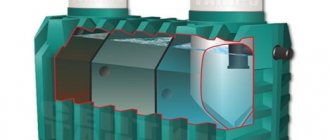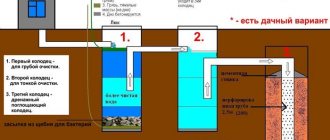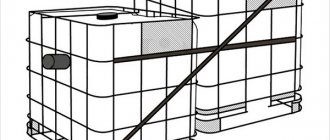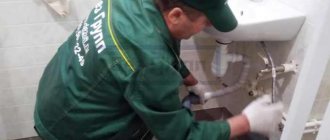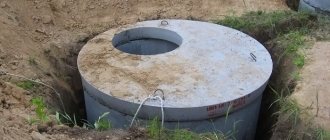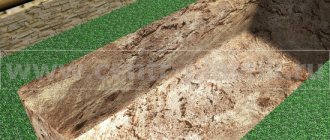Types of cesspools
Diagram of a septic tank with overflow
Treatment plants vary in design and scope of application. Most often, the following types of pits are installed on personal plots:
- Absorbing without bottom. The structures are suitable for areas where the daily volume of wastewater does not exceed a cubic meter. The principle of their operation is that wastewater, passing through the drainage layer in the well, is purified and then absorbed by the soil.
- Sealed chambers for the accumulation of sewage. They are environmentally safe, since waste water does not penetrate into the environment - it is pumped out by sewer machines. An option for such a treatment design are storage septic tanks - due to the influence of biological products, they need to be cleaned less often.
- Settlers with overflow. This is an even more advanced option. After clarification, the liquid can be used for watering garden plants.
Each of the varieties can be made with your own hands, including a sump with overflow for sewerage in a private house.
General information
Tanks collect sewage waste
Substances of inorganic origin sink to the bottom of the first compartment. The clarified liquid flows by gravity through an overflow pipe, arranged at an angle of inclination, into another chamber. Liquid fractions are separated from solid ones.
Attention! This type of device does not require power supply, which is suitable for use in the country.
The main advantage of the device is energy independence. They can be installed in private homes and country houses. During operation, no additional equipment is required.
Materials for the device. The structure of the septic tank is made of brick, plastic in the form of ready-made Eurocubes. Reinforced concrete rings are often used for construction. The concrete structure is easy to install, but special equipment will be required during work, because the concrete rings are very heavy.
Parameters for the bypass well
To build an overflow septic tank, you need to correctly calculate the dimensions of the structure. The first step is to develop a general home sewage system. Then select the device type.
Calculate the volume of containers for the well to prevent waste water from overflowing over the edge of the well. Apply the formula for calculations: V pc = 3 x Vn xn x Kz.
-Vпk is equal to the volume of all tanks in the septic tank.
-Vn is equal to the daily fluid intake per person.
-n is the number of residents in the house.
-kz is equal to the safety factor in case of guests arriving. It is equal to 1.3 (30 percent).
The number of containers in an overflow septic tank depends on the required level of wastewater treatment. With more chambers, the output water becomes cleaner.
Container with drainage
The method of laying the drainage layer for large elements in the second compartment is determined depending on the level of underground flow, soil characteristics. The base of the container is filled with gravel and expanded clay. Thus, it is possible to build a structure with a natural filter, in which debris particles will be retained, and water will go into the ground under the device.
To do this, the following conditions must be met:
1.groundwater flows low.
2.groundwater rises low during floods.
3.Under the drainage tank there is non-clayey soil that does not quickly absorb water.
A drainage field is suitable for drainage in a sewer system in a country house. It is a long container with holes through which moisture is distributed to be absorbed into the soil over a wide area, preserving the ecology of the environment.
Cleaning tanks with bottoms
If there are no necessary conditions for organizing a container without a bottom, then a septic tank with a second chamber with a bottom is installed. It must be sealed. The container with the bottom is cleaned as soon as it is filled with insoluble suspensions. This requires the services of vacuum cleaners.
There are methods that reduce the amount of undissolved elements in the chamber. This allows you to reduce the frequency of the need to clean the overflow well in a private house. Biorefinement and mechanical methods are considered popular for use.
Biological treatment involves the use of anaerobic and aerobic bacteria. Microorganisms, multiplying, break down almost 70-80 percent of the deposited particles. The mechanical cleaning method is called in-depth. In this situation, during the construction of a well, pipes with holes are placed at the bottom of the structure. Air is removed from the tubes, increasing the process of mass exchange in the drains. Attention! The purification of the liquid at the outlet reaches almost one hundred percent; it can be used for watering the garden.
The principle of operation of the design
The principle of operation of a three-chamber septic tank
Treatment facilities of this type are capable of filtering sewage waste up to 90–95%. The design of an overflow two-chamber septic tank is quite simple. The two tanks are connected to each other using plastic pipes.
There may be more containers, but a couple are enough for a small cottage. The first acts as a settling tank and reservoir for water-insoluble heavy dirt particles. It must have a hatch for the hose of the sewage disposal equipment, since such septic tanks still require pumping, although less often than just storage tanks.
Once in the second chamber, the clarified liquid is repeatedly settled and purified by bacterial flora, which feeds on organic matter and biowaste.
After cleaning in the second container, the liquid is sent to the filtration fields or to the infiltrator. It is also possible to install filter screens and grease traps in the overflow tube, which retain some of the dirt when the wastewater is overflowed from one container to another. Filtration devices contain bacteria that help decompose waste. When using an aerobic type of microorganisms, the structure is equipped with ventilation shafts or an aerator.
There is an even simpler option: the cleaning device also consists of two containers, the first being sealed, and the second being installed without a bottom. Instead, a mixture of sand and crushed stone is poured, which acts as a filter. Flowing from the first container to the second, the clarified liquid undergoes mechanical purification, passing through a sand and gravel bed, and then enters the ground.
Practical tips and recommendations ↑
When digging a trench to lay a pipe to a septic tank, maintain an inclination angle of 2 cm for each linear meter. This solution will allow the waste liquid to freely drain by gravity into the sump.
When installing an autonomous septic tank in a cold region, take care of additional insulation not only of overflow pipes, but also of tanks. If this condition is not met, under the influence of sub-zero temperatures the liquid will turn into ice, thereby disrupting the operation of the entire system.
In order for an overflow septic tank to function properly, it must be serviced at least once a year. Sewage equipment is used to pump waste out of the first container.
Do you want to delay the cleanup period? Use biological products. The bacteria they contain are capable of corroding organic waste. But keep in mind that these bacteria are vulnerable to acids and chlorine. Therefore, try to minimize the use of aggressive chemicals in everyday life.
In general, a septic tank system based on the overflow principle is easy to install and maintain. A well-designed cleaning system with proper care will serve well for more than half a century.
Advantages and disadvantages of a pit with overflow
The main advantage of sewerage is the absence of frequent cleaning with special equipment. In addition, the settled liquid can be used for household needs: watering plants, fertilizing beds.
Additional advantages of such a device:
- Cleansing efficiency. Sewage water undergoes several stages of purification in the settling and filtration chambers.
- High throughput – 0.2–0.5 cubic meters per hour.
- Almost complete absence of odors.
The disadvantages include the complexity of installation. It consists in accurately calculating the angle for connecting the pipe and the location of the containers in relation to each other. Also, construction will be more expensive compared to a regular pit, because even a two-chamber overflow device requires a pair of wells for sewerage.
Principle of operation
Let's start with the fact that there are two types of septic tanks: two-chamber and multi-chamber. The two-chamber one is the simplest in design. Its components: a settling tank, where a three-day process of separating wastewater into liquid and solid waste takes place; a filter well without a sealed bottom, into which purified water flows from the sump and goes into the ground. In order for the filter well to be less polluted and the quality of water purification to be better, several settling tanks can be combined into a sequential chain.
A multi-chamber septic tank is different in that when used, the degree of wastewater purification is much higher, and removing sediment from it is faster and more convenient. But it is important to know that even a ten-day septic tank will not completely clean the wastewater, since the bulk of the sediment is in the 1st section, without re-contaminating the water with waste products.
Construction Materials
To install concrete rings you need special equipment
Concrete rings, bricks and even old car tires are used to construct overflow structures. The first option is preferable: it is inexpensive and reliable. But for each camera you can choose your own version.
Additionally, you will need gravel and sand, and a concrete mixture.
Tools that will be useful are a shovel, a rope, a bucket, a hammer, a chisel, and devices for mixing concrete mortar.
Advantages and disadvantages
The advantages of overflow sewerage include:
- simplicity of design, possibility of independent construction;
- reliability, absence of failures or breakdowns;
- the possibility of recycling wastewater almost in full;
- there is no need to connect the system to the power supply;
- if necessary, you can increase the number of sections;
- long service life;
- construction from rings is simplified, since it is possible to perform waterproofing even before descending into the nest;
- there is the possibility of high-quality sealing;
- concrete rings have all the necessary components - bottoms, covers. This allows the creation of tanks of any volume as long as the ground conditions are suitable.
An overflow well for sewerage also has some disadvantages:
- the need to comply with installation rules, strict adherence to permissible distances to buildings, roads or site boundaries;
- large volume of earthworks;
- with high groundwater levels or severe frost heaving of the soil, construction becomes difficult or impossible;
- the complex occupies a considerable amount of space that cannot be used anymore;
- during assembly you cannot do without lifting equipment;
- the need for periodic cleaning.
Overflow sewerage made from concrete rings has approximately the same number of advantages and disadvantages. However, its popularity is great and does not reduce its position. This is due to the availability of materials and ease of construction.
Also read: Installation of sewerage treatment plants: how they work, device
Preparation for construction of the structure
For the pit, a site is selected at a distance of at least 20 meters from the nearest water intake point and at least 10 meters from the building. The groundwater level should not be high. The liquid in the receiver should be located below the freezing layer of the ground.
Each drain is positioned to each other at an angle of up to 20 degrees. Their connection is made with pipes in the shape of the letter T. These fitting elements are installed at a distance of at least a meter from the uppermost part of the tank.
The volume of each tank is at least two cubic meters. It is calculated depending on the total number of occupants and plumbing fixtures. The more there are, the wider and deeper the cleaning chambers will be required.
How to choose the right location for an overflow sewer on a site?
In accordance with the legislation of the Russian Federation, in order to avoid soil erosion by runoff water, the sanitary protection zone from the overflow sewer to a residential building must be 5 meters, and to the neighboring site - 4 meters.
If the construction of treatment facilities is planned on a garden plot, it is necessary to maintain a distance of 2 - 4 meters from trees, since the root system can damage the structure.
How to correctly calculate the volume for a future treatment plant
To correctly calculate the volume of a septic tank, it is necessary to take 200 liters per day per user. Smaller volumes are not permissible, since you and your loved ones will suffer first.
Materials needed for construction:
- concrete rings of standard sizes with d=1.5 m;
- floor slab;
- hatch, preferably made of cast iron.
The more sections a septic tank has, the easier the cleaning work is, therefore, the service life of the facility increases.
Which overflow septic tank is in demand
If we talk about popular overflow septic tanks, it is worth highlighting the “Maple” series.
See what options you can choose from:
- For high and low groundwater.
- For large and small families. Cleaning capacity reaches 750 liters per day.
- For sandy soil and soils prone to frost heaving, because the tank body is made of sheet polypropylene, which has good strength.
If there is a need to protect the system from frost, you can choose “Maple”, equipped with elongated necks. The main thing is that even after years of inactivity, the sewage system with this septic tank will work without problems. Be sure to evaluate the opportunity to purchase one of the presented models of septic tanks from the “Maple” series.
Recommendations: how to save on construction
When a homemade septic tank is being installed and there is no possibility or desire to involve special equipment or a team, you can do this: remove the soil as the ring is lowered into the pit. The ring, under the influence of its own weight, sinks into the hole, and the master simply digs up the soil. Then the bottom is concreted after and only inside the container.
In this case, it is impossible to make high-quality hydro- and thermal insulation from the outside. And the design turns out to be less reliable, but still, this method has a right to exist.
Trying to reduce the cost of installing a septic tank for a country house, you can make a structure in the form of a triangle, which will save space and reduce the scale of excavation work. But here it is worth considering that the inspection entrance in the system will be the same for all rings, so the overflows are located outside its accessibility zone.

